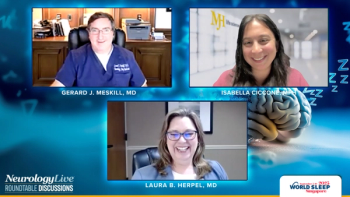
Onset Presentation Predicts First Relapse, Long-Term Disability in Pediatric AQP4-IgG NMOSD
Investigators suggest recognition of predictors can aid in directing future clinical trials, as well as inform early therapeutic decisions in this patient population.
Data from a recent study in pediatric-onset aquaporin-4 antibody (AQP4-IgG) neuromyelitis optica spectrum disorder (NMOSD) found that age and symptoms at onset, race, and resistance to acute therapy at first onset attack help to predict long-term visual, motor, and cognitive disabilities.
A total of 49 patients with pediatric-onset AQP4-IgG NMOSD were enrolled in the retrospective UK multicenter cohort study. Patients had a mean disease onset age of 12 years (standard deviation, 4.1) and varied in race, as 38.8% were White (n = 19), 34.7% were Black (n = 17), 20.4% were Asian (n = 10), and 6.1% were mixed race (n = 3). Of the studied patients, 87.7% of whom were female (n = 43), it was found that 52.3% had their first relapse within 1 year of the onset of disease and those with an onset age younger than 12 years were more likely to have an earlier first relapse (P = .030). When compared to patients between the ages of 12 and 18, there was no difference in time to immunosuppression, investigators noted.
The median disease duration for the cohort was 79 months, with 34.3% of patients reporting permanent visual disability, 20.7% with an Expanded Disability Status Score (EDSS) score of 4, and 25.8% with cognitive impairment at that time. Non-Asian children were the more likely to reach the EDSS score of 4 considerably earlier (P = .054), investigators noted. It was also found that cerebral syndrome (CS) presentations predicted cognitive impairment (P = .048), more so if a patient was resistant to steroids (P = .034).
READ MORE:
When considering association with race, it was found that visual disability (P = .032) and optic neuritis presentations (P = .002) were associated with White participants. Additionally, White patients were found to have a younger age of disease onset when compared to other races (P = .008), while Black patients were older (P = .025). Black patients were also the most likely to be refractory to intravenous methylprednisolone and require acute second-line therapies (P = .018).
“Existing studies on long-term outcomes of pediatric-onset NMOSD were limited to mixed cohorts of seropositive and seronegative patients, had shorter disease duration, or had more heterogeneity across different countries and healthcare systems,” corresponding author Jacqueline Palace, MD, FRCP, consultant neurologist, Nuffield Department of Clinical Neurosciences, University of Oxford, et al wrote. “However, we noted comparable demographic onset features (median age at onset, female to male ratio, and black predominance) in a single-country (USA), 1 year of disease duration study on pediatric-onset AQP4-IgG disease. We reported an elevated incidence of area postrema syndrome as onset presentation compared with other pediatric AQP4-IgG NMOSD studies. This may relate to ‘hindsight’ diagnoses and improved awareness of the area postrema clinical presentation.”
Included patients were likely to present area postrema and/or brainstem syndrome (48.9%; n = 24), as well as unilateral or bilateral optic neuritis (47%; n = 23), CS (28.6%; n = 14), and transverse myelitis (24.5%; n =12). Of immunosuppressants, rituximab was found to be the superior first-line therapy, when compared to azathioprine and mycophenolate mofetil, as it had less discontinuations and none of the 6 patients taking rituximab had relapses over a median follow-up period of 4.5 years.
The study was limited as AQP4-IgG NMOSD is a rare disease and thus there was a low number of observations made. A bigger sample of patients with AQP4-IgG NMOSD should be studied in a larger prospective study, performing a multivariate analysis with multiple comparison correction. The study also had a longer follow-up period, introducing the potential for variability in treatment approaches, depending on when patients began presenting.
“With improved predictive data in pediatric AQP4-IgG NMOSD, clinical trial powering can be more accurately calculated, and individualized monitoring, support, and treatment regimens can be offered with the aim of improving outcomes in children,” Palace et al wrote.
REFERENCE
Camera V, Messina S, Elhadd KT, et al. Early predictors of disability of paediatric-onset AQP4-IgG-seropositive neuromyelitis optica spectrum disorders. BMJ Journals. Published online September 18, 2021. doi:10.1136/jnnp-2021-327206
Newsletter
Keep your finger on the pulse of neurology—subscribe to NeurologyLive for expert interviews, new data, and breakthrough treatment updates.




































